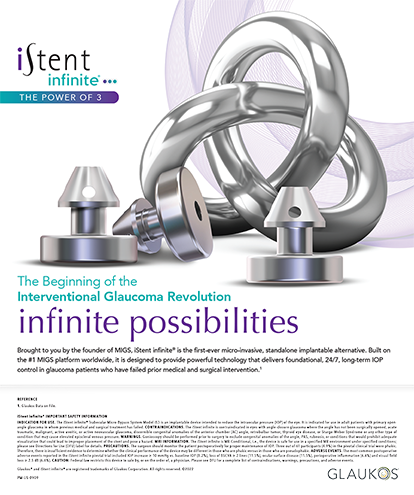Is laser pupilloplasty an effective way to recenter the pupil over a diffractive IOL?
ALAN M. BERG, MD
I have seen many cases of slight pupillary decentration in relation to a diffractive IOL. Most of these patients have not had visual complaints. I performed a laser pupilloplasty on those who did have visual disturbances, and none of these patients has experienced a worsening of symptoms.
STEVEN J. DELL, MD
I have never performed a laser pupilloplasty for this indication. From an optical standpoint, I do not fully understand why it helps. If a diffractive IOL is decentered from the line of sight and from the pupil's center, then moving the pupillary center will have no effect on the mismatch between the center of the IOL and the line of sight. I suppose it might transform the nature of the rings that the patient sees under scotopic conditions by making them more symmetrical. One-piece
diffractive-optic IOLs tend to stay where you place them, which may be an advantage or disadvantage depending on the situation. Many surgeons intentionally nudge these lenses a bit to the nasal side of the pupil to coincide more closely with the line of sight. Three-piece diffractive IOLs tend to align with the anatomic center of the capsular bag. Any IOL is vulnerable to a late positional shift with capsular contraction, but patients with a diffractive IOL would obviously be more sensitive to this phenomenon.
LEE T. NORDAN, MD
From a theoretical perspective, a doughnut lens (a lens without a functional center) has the same optical capability as a complete lens. From a practical standpoint, pupillary enlargement should be considered if the edge of the iris is near the midline of the IOL or if the pupil is grossly decentered. In the case of the former, pupillary enlargement is necessary because the edge of the iris might cause a shadow. In the case of the latter, an exceedingly decentered pupil may cause a cosmetic issue. If the pupil's ability to constrict is affected significantly, an increase in glare and haloes—especially with a diffractive IOL—should be factored into the risk/benefit ratio of an alteration in pupillary shape.
J. E. "JAY" MCDONALD II, MD
Studies by Scott MacRae, MD, on higher-order aberrations found that diffractive lenses that are tilted and decentered induce a considerable amount of visual disturbance.1 Discussions about optical axis, visual axis, pupillary center, and the bag's center as well as angle kappa have generated much debate about where an IOL should ideally be placed. Unfortunately, we are confined to the dynamics of the bag for centration, and we are unable to control postoperative capsular contraction. I never appreciated the variables associated with the bag's configuration and tectonics until I began implanting the Crystalens Five-O and HD (Bausch & Lomb, Rochester, NY). They are the first hinged lenses that allow for a significant amount of anterior to posterior vaulting depending on the characteristic of the bag.
I have seen cases where decentered diffractive IOLs have caused visual disturbance. I eliminate astigmatism before considering options for centration. When astigmatism is fixed, but visual complaints are unanswered by defocus, moving the entrance pupil toward the center of the IOL makes the most sense.
JEFFREY WHITMAN, MD
I believe that the center of a multifocal lens needs to be centered on the line of sight. Simply moving the pupil to coincide with the center of the optic may cause more aberration. With the ReZoom IOL (Abbott Medical Optics Inc., Santa Ana, CA), when the pupil is simply not big enough at rest, a symmetric pupilloplasty at the midperipheral iris will expose more rings and improve the range of visual function.
Section editor John F. Doane, MD, is in private practice with Discover Vision Centers in Kansas City, Missouri, and he is a clinical assistant professor for the Department of Ophthalmology, Kansas University Medical Center, in Kansas City, Kansas. Dr. Doane may be reached at (816) 478-1230; jdoane@discovervision.com.
Alan M. Berg, MD, is in private practice with Berg-Feinfield TLC Vision Correction in Burbank, California. Dr. Berg may be reached at (818) 980-2020; aberg@bergfeinfield.com.
Steven J. Dell, MD, is the director of refractive and corneal surgery for Texan Eye Care in Austin. Dr. Dell may be reached at (512) 327-7000.
Lee T. Nordan, MD, is a technology consultant for Vision Membrane Technologies, Inc., in San Diego. Dr. Nordan may be reached at (858) 487-9600; laserltn@aol.com.
J. E. "Jay" McDonald II, MD, is the director of McDonald Eye Associates in Fayetteville, Arkansas, and he is the editor of the ASCRS Cataract and Refractive Internet Forum. He is a consultant to Bausch & Lomb. Dr. McDonald may be reached at (479) 521-2769; mcdonaldje@mcdonaldeye.com.
Jeffrey Whitman, MD, is the president and chief surgeon of the Key-Whitman Eye Center in Dallas. He is a member of the speakers' bureau for Abbott Medical Optics Inc. and is a consultant to Bausch & Lomb. Dr. Whitman may be reached at (800) 442-5330; whitman@keywhitman.com.
- MacRae SM, Yoon G, Chen M. Optical analysis of aberrations, depth of focus, and retinal image quality in Crystalens HD and Five-O IOLs. Paper presented at: The 2009 ASCRS Symposium on Cataract, IOL and Refractive Surgery; April 5, 2009; San Francisco, CA.


